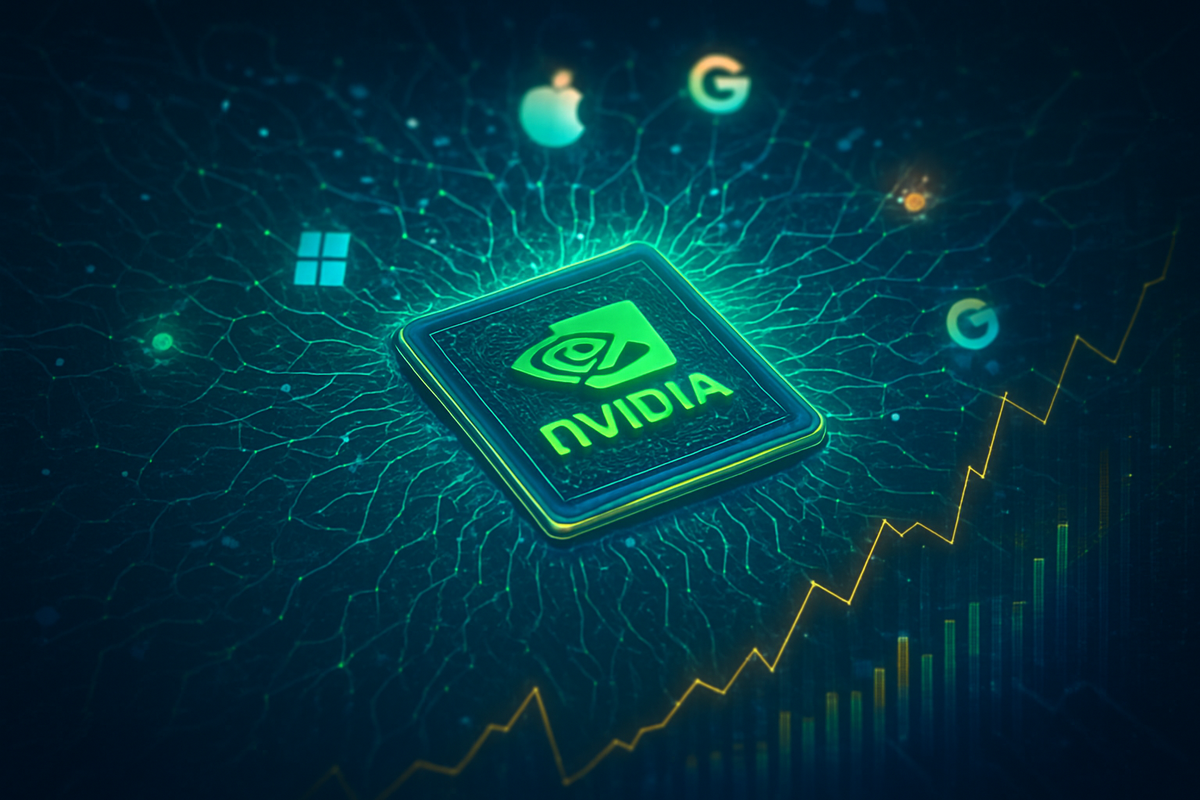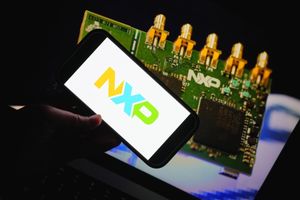
The financial world watches in awe as the "Magnificent Seven" technology giants continue to dictate market trends, but as of late 2025, one titan stands head and shoulders above the rest: Nvidia (NASDAQ: NVDA). The chipmaker's unprecedented surge, culminating in a historic $5 trillion market capitalization, underscores a profound shift in market dynamics, driven almost entirely by the relentless march of artificial intelligence. This monumental achievement not only solidifies Nvidia's position as the world's most valuable company but also intensifies the debate around market concentration and the sustainability of AI-fueled valuations.
Nvidia's ascent is more than just a corporate success story; it's a testament to the transformative power of AI and its foundational infrastructure. The immediate implication is a reinforced, almost feverish, investor confidence in the AI sector, channeling vast amounts of capital into companies positioned at the forefront of this technological revolution. However, it also raises critical questions about the broader market's health, as an increasingly significant portion of overall S&P 500 growth is attributable to a select few, with Nvidia leading the charge.
The Unstoppable Force: Nvidia's AI Dominance
The "Magnificent Seven" – comprising Apple (NASDAQ: AAPL), Nvidia (NASDAQ: NVDA), Microsoft (NASDAQ: MSFT), Amazon (NASDAQ: AMZN), Alphabet (NASDAQ: GOOGL), Meta Platforms (NASDAQ: META), and Tesla (NASDAQ: TSLA) – have collectively reached an astonishing market capitalization of $20.9 trillion by October 2025, accounting for nearly 37% of the S&P 500's total value. Their combined performance has been the primary engine driving major indices to successive record highs throughout 2024 and 2025. However, within this elite group, Nvidia's trajectory has been nothing short of meteoric.
On October 29, 2025, Nvidia made history by becoming the first company ever to surpass a $5 trillion market capitalization, a mere three months after reaching the $4 trillion mark. This rapid accumulation of value highlights the intense demand for its Graphics Processing Units (GPUs), which are the bedrock of the AI industry. Nvidia commands an estimated 70% to 95% market share in AI accelerators, making it an indispensable partner for virtually every major AI developer and cloud provider. The company's stock has surged an astounding 50% year-to-date in 2025, following a remarkable 171% rise in 2024, contributing nearly a fifth of the S&P 500's 17% advance this year alone. For fiscal year 2025, Nvidia reported total revenue of $130.5 billion, a staggering 114% increase from FY2024, with its data center segment contributing approximately $102 billion. The company has already reported over $100 billion in revenue for the first half of 2025 and projects $500 billion in GPU sales by the end of 2026, with exceptionally high demand for its next-generation Blackwell and upcoming Rubin products.
The timeline leading to this moment has been characterized by an escalating global investment in AI, from generative AI models to autonomous systems. Nvidia's foresight in pivoting to GPU-based parallel computing years ago positioned it perfectly for this boom. Key players include not only the "Magnificent Seven" themselves, but also hyperscale cloud providers like Microsoft (NASDAQ: MSFT) Azure, Amazon (NASDAQ: AMZN) Web Services, and Google (NASDAQ: GOOGL) Cloud, all of whom are massive consumers of Nvidia's hardware. Initial market reactions have been overwhelmingly positive, with reinforced optimism around AI, though concerns about valuation and market concentration are also growing.
Navigating the AI Wave: Winners and Challengers
Nvidia's unprecedented success naturally creates a distinct set of winners and presents significant challenges for others in the technology ecosystem. The most obvious winner is Nvidia (NASDAQ: NVDA) itself, whose dominance in AI chip manufacturing positions it as the central nervous system of the global AI infrastructure. Companies that are deeply integrated into Nvidia's ecosystem or provide complementary AI software and services are also poised for significant gains. This includes firms specializing in AI model development, data center cooling solutions, and advanced networking hardware essential for large-scale AI deployments. Hyperscale cloud providers like Microsoft (NASDAQ: MSFT), Amazon (NASDAQ: AMZN), and Alphabet (NASDAQ: GOOGL) continue to win by offering AI-as-a-service, leveraging Nvidia's powerful GPUs to attract and retain enterprise customers.
However, Nvidia's outsized influence also creates a challenging landscape for competitors. Companies like Advanced Micro Devices (NASDAQ: AMD) and Qualcomm (NASDAQ: QCOM) are actively investing in their own AI accelerator chips, but they face an uphill battle against Nvidia's established market share, robust software ecosystem (CUDA), and strong customer relationships. While these challengers have made inroads, displacing Nvidia from its perch will require substantial innovation and market penetration. Furthermore, some of Nvidia's largest customers, the hyperscalers themselves, are increasingly developing in-house AI chips (e.g., Google's TPUs, Amazon's Trainium/Inferentia) to reduce dependency and control costs. While this doesn't immediately threaten Nvidia's lead, it signifies a long-term strategic pivot that could cap future growth if successful. Companies heavily reliant on older, non-AI-optimized hardware or those slow to integrate AI into their offerings may find themselves at a competitive disadvantage, potentially losing market share and investor interest to more agile, AI-focused counterparts.
Broader Implications and Historical Parallels
Nvidia's ascendancy and the continued dominance of the "Magnificent Seven" fit squarely into broader industry trends driven by the pervasive adoption of artificial intelligence and the ongoing digital transformation. The demand for massive computing power, fueled by increasingly complex AI models, is driving unprecedented capital expenditure in data centers globally. This trend extends beyond just chips, creating ripple effects across the entire technology supply chain, from advanced cooling systems and power infrastructure to high-speed interconnects and specialized software. Competitors are forced to accelerate their R&D efforts, leading to a vibrant, albeit fiercely competitive, innovation landscape. Strategic alliances are also forming, as companies seek to combine their strengths to challenge established leaders or carve out niche markets within the AI ecosystem.
Regulatory bodies and policymakers are increasingly scrutinizing the market concentration exemplified by the "Magnificent Seven." Concerns about potential antitrust issues, data privacy, and the sheer economic power wielded by these few companies are gaining traction globally. Geopolitical considerations, particularly regarding the export of advanced AI chips to strategic regions like China, also play a significant role. Discussions between world leaders, such as the anticipated meeting between U.S. President Donald Trump and Chinese President Xi Jinping concerning Blackwell chip exports, could profoundly influence Nvidia's market access and future revenue streams. Historically, periods of extreme market concentration, such as the "Nifty Fifty" in the 1970s or the dot-com bubble of the late 1990s, have often preceded significant market corrections or shifts. While the underlying technological advancements of today are arguably more fundamental, the rapid valuations and dependence on a few key players draw parallels that warrant careful consideration from investors and regulators alike.
The Road Ahead: Navigating an AI-Powered Future
The immediate future for Nvidia (NASDAQ: NVDA) and the broader AI market appears poised for continued robust growth, at least in the short term. Demand for next-generation AI hardware, particularly Nvidia's Blackwell and Rubin platforms, remains exceptionally high, with significant revenue visibility extending into 2026. This suggests sustained capital expenditure from hyperscalers and enterprises eager to deploy advanced AI capabilities. However, the long-term outlook will hinge on several critical factors: Nvidia's ability to maintain its technological lead amidst intensifying competition, the successful development of new AI applications that justify escalating infrastructure costs, and the stability of global supply chains.
Strategic pivots will be crucial for all players. Nvidia will need to continue innovating at a rapid pace, expanding its software ecosystem, and potentially diversifying its revenue streams beyond pure hardware. Competitors like AMD (NASDAQ: AMD) and Qualcomm (NASDAQ: QCOM) will need to focus on differentiated offerings or niche markets where they can gain a competitive edge. Hyperscalers' efforts to develop in-house AI chips represent a significant strategic adaptation aimed at reducing vendor lock-in and optimizing their cloud infrastructure. Market opportunities will emerge in specialized AI software, services, and niche hardware components, while challenges will include managing supply chain disruptions, navigating complex geopolitical trade policies, and addressing the immense energy consumption demands of large-scale AI. Potential scenarios range from a sustained, albeit diversifying, AI boom to a market correction if AI spending fails to meet elevated expectations or if competition erodes profit margins.
A New Era of Market Dominance
The rise of Nvidia (NASDAQ: NVDA) to a $5 trillion market capitalization marks a pivotal moment in financial history, solidifying its role as the undisputed kingpin of the AI revolution and fundamentally reshaping the dynamics of the "Magnificent Seven." While the collective power of these tech giants continues to drive market performance, Nvidia's outsized influence underscores a market increasingly concentrated around the foundational technologies of artificial intelligence. The key takeaway is clear: AI is not merely a trend but a transformative force, and the companies providing its core infrastructure are reaping unprecedented rewards.
Moving forward, the market will be a delicate balance between sustained AI-driven growth and increasing scrutiny of valuations and market concentration. Investors should watch closely for Nvidia's upcoming earnings reports, paying particular attention to its guidance on demand for next-generation products and any commentary on competitive pressures. Beyond Nvidia, the performance of other AI infrastructure providers, the success of in-house chip development efforts by hyperscalers, and the evolving regulatory landscape will be critical indicators. The lasting impact of this era could be a permanently altered technology landscape, where AI capabilities become the primary determinant of corporate value and competitive advantage, forcing all companies to adapt or risk being left behind in the wake of this technological tsunami.
This content is intended for informational purposes only and is not financial advice







